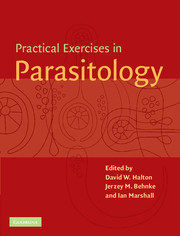Book contents
- Frontmatter
- Contents
- List of contributors
- Preface
- General advice
- 1 Observational Exercises on Parasites
- 2 Ecology
- 3 Physiology and Biochemistry
- 4 Pathology and Immunology
- 5 Chemotherapy
- 6 Molecular Parasitology
- 6.1 Purification of DNA
- 6.2 DNA digestion and gel electrophoresis
- 6.3 Restriction enzyme mapping
- 6.4 Construction of a genomic library
- 6.5 Detection and differentiation of Entamoeba histolytica and E. dispar by PCR
- 6.6 Differentiation between parasite species by agglutination and detection of parasite surface carbohydrates, using non-conjugated lectins
- 6.7 Tentative identification of parasite and tissue surface carbohydrates by conjugated lectins
- 7 Behaviour
- Appendix 1 Reagent index
- Appendix 2 UK suppliers
- Appendix 3 US suppliers
- Index
6.6 - Differentiation between parasite species by agglutination and detection of parasite surface carbohydrates, using non-conjugated lectins
Published online by Cambridge University Press: 05 June 2012
- Frontmatter
- Contents
- List of contributors
- Preface
- General advice
- 1 Observational Exercises on Parasites
- 2 Ecology
- 3 Physiology and Biochemistry
- 4 Pathology and Immunology
- 5 Chemotherapy
- 6 Molecular Parasitology
- 6.1 Purification of DNA
- 6.2 DNA digestion and gel electrophoresis
- 6.3 Restriction enzyme mapping
- 6.4 Construction of a genomic library
- 6.5 Detection and differentiation of Entamoeba histolytica and E. dispar by PCR
- 6.6 Differentiation between parasite species by agglutination and detection of parasite surface carbohydrates, using non-conjugated lectins
- 6.7 Tentative identification of parasite and tissue surface carbohydrates by conjugated lectins
- 7 Behaviour
- Appendix 1 Reagent index
- Appendix 2 UK suppliers
- Appendix 3 US suppliers
- Index
Summary
Aims and objectives
Using commercial lectins, these two exercises are designed to:
Distinguish between different species of parasites and two strains of the same parasite species.
Determine the type of carbohydrate present on the parasite surface membrane.
Introduction
Lectins (often referred to as agglutinins) are proteins or glycoproteins that bind specifically to carbohydrates, usually present as glycoconjugates, on cell or tissue surfaces or in cell tissue fluids (Sharon & Lis, 1989; Jacobson, 1994). Lectin reactivity is generally designated according to the monosaccharides or oligosaccharides that cause inhibition of lectin-mediated agglutination of cells or adherence to cell membranes.
Lectins have been widely used in parasitology to detect and determine the types of saccharide moieties on the surface of trypanosomatids, e.g. Crithidia (Petry et al., 1987), Leishmania (Schottelius & Aisen, 1994) and Trypanosoma species (Maraghi et al., 1989), to demonstrate differences between parasite growth and stationary phases (Jacobson & Schnur, 1990) and to distinguish between the different stages of the trypanosomatid life cycle (Rudin et al., 1989). In addition, lectins have been employed to differentiate between parasite species (Schottelius & Aisen, 1994) and in the identification of various strains (Schnur & Jacobson, 1989) and stocks (Schottelius, 1987) of these flagellates. The following methods are applied to kinetoplastid flagellates but can be adapted to study other unicellular parasites.
- Type
- Chapter
- Information
- Practical Exercises in Parasitology , pp. 375 - 384Publisher: Cambridge University PressPrint publication year: 2001



